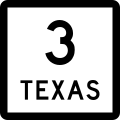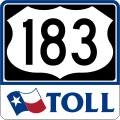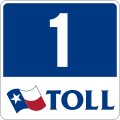Texas state highway system
|
Interstate Highways, U.S. Highways, State highways, and Farm To Market highways | |
| System information | |
|---|---|
| Length | 72,978.175 mi[1] (117,446.988 km) |
| Notes | All classes of state-numbered highways are generally state-maintained. |
| Highway names | |
| Interstates | Interstate X (I-X) Interstate Highway X (IH X) |
| US Highways | U.S. Highway X (US X) |
| State | State Highway X (SH X) |
| Loops: | Loop X |
| Spurs: | Spur X |
| Recreational: | Recreational Road X (RE X) |
| Farm or Ranch to Market Roads: | Farm-to-Market Road X (FM X) Ranch-to-Market Road X (RM X) |
| Park Roads: | Park Road X (PR X) |
| System links | |
Texas state highways are a network of highways owned and maintained by the U.S. state of
History

The Texas State Highway System can trace its roots to the establishment of the Texas Highway Department on April 4, 1917. Administrative control of the department was given to a three-member commission appointed by the governor for two-year terms. On June 21, 1917, the commission conducted its first public hearing to solicit input on potential highway routes. The committee also divided the state into six divisions to be headquartered in
In 1921,
By 1927, the highway system covered 17,960 miles (28,900 km), of which 96 miles (154 km) were concrete, 1,060 miles (1,710 km) were asphalt, 5,000 miles (8,000 km) were gravel, shell or stone, and 10,000 miles (20,000 km) were clay or soil.[3]

In 1951, a 50-mile (80 km) section of the Gulf Freeway (now I-45) opened, becoming Texas' first urban freeway. In 1957, the state began receiving federal funding for the construction of the Interstate Highway System. The first section of Interstate Highway from county line to county line to open in the state was a 43-mile (69 km) section of I-35 in Bexar County. By 1967, the highway system controlled 66,000 miles (106,000 km) of highway.[5]
In 1984, US 66 was replaced by I-40 and the US 66 designation was removed from the state highway system the following year.[6]
In 1992, the 3,200 miles (5,100 km) of Interstate Highway System in Texas was completed with the opening of a six-mile (9.7 km) section of
Types of highways

Interstate Highways

The Interstate Highway System in Texas covers 3,233.4 miles (5,203.7 km) and consists of ten primary highways, seven auxiliary highways, and the splitting of both Interstate 35 (I-35) and Interstate 69 into multiple letter-suffixed branches. The Interstate Highway with the longest segment in Texas is I-10 at 880.6 miles (1,417.2 km). The shortest in the state is I-110 at 0.9 miles (1.4 km).
The construction of the Interstate Highway System in Texas actually began well before these routes were designated as Interstate Highways. A 50-mile (80 km) stretch of the
Construction is ongoing for an extension of
U.S. Highways

The
.The Interstate Highways have replaced several portions of the U.S. Highway network in Texas and as a result, they have been removed from the State Highway System. Several examples include
State Highways
A State Highway (SH) is funded and maintained by the state.
State Highway Loops and Spurs
State highway loops and spurs are short links in the State Highway network. They are generally numbered chronologically, and the lower numbers are older routes. Thus, spurs and loops are not related to similarly numbered main state highways. Typically, a loop connects two state or national highways, and a spur connects a state highway to a Farm to Market Road or other lower rated road. Many loops are either bypasses around significant portions of populated areas or older bypassed state or national highways. One loop—around Houston—is labeled Beltway 8. The first loops and spurs were defined in 1939; prior to that, the roadways had been suffixed segments of the main state highways of which they branched.
Business routes
Business routes are assigned to many old alignments of Interstate Highways, U.S. Highways, State Highways and Farm to Market Roads that have been bypassed. In addition to the numerical designation, a unique lettered suffix is assigned to each business route along the highway—for instance, Business Interstate Highway 40-D and Business Farm to Market Road 1960-A. (Not all routes start from A, and letters are sometimes skipped.) These letters are included on the sign in small print below the number. The sign specifications for business Interstate highways do not include the letter, but it has been added to many signs. Prior to 1991, business routes were assigned loop or spur numbers, but signed as business routes (with a BUSINESS plate above the shield for the main route). In 1991, all the business routes were assigned official designations, and their former loop and spur numbers were eliminated.
Farm to Market Roads
Farm to Market Roads generally exist in
Park and Recreational Roads
Park Roads and Recreational Roads serve state or national parks and "recognized recreational areas"; the first ones were defined in 1937 and 1970 respectively. All roads in state parks are maintained by TxDOT, but are generally not numbered.[12]
Toll roads
One characteristic of the highways in Texas are its
War Highways
War Highways were designated from 1942-1943. All were cancelled or redesignated by 1947.
See also
- List of Dallas-Fort Worth area freeways
- List of Houston highways
- List of highways in San Antonio
References
- ^ Data Management, Transportation Planning & Programming (2021). Roadway Inventory Annual Reports (PDF) (Report). Texas Department of Transportation. Retrieved April 17, 2024.
- ^ a b Texas Department of Transportation. "State Highway, Loop and Spur Facts". Texas Department of Transportation. Retrieved April 6, 2012.
- ^ a b c d Texas Department of Transportation. "TxDOT History: 1917–1930". Texas Department of Transportation. Archived from the original on February 16, 2007. Retrieved March 7, 2008.
- ^ Texas State Highway Commission, Office of State Highway Engineer (July 1917). Map Showing Proposed System of State Highways (Map) (June 1917 ed.). 1:2,112,200. Austin: Texas State Highway Commission. Retrieved March 7, 2008.
- ^ a b Texas Department of Transportation. "TxDOT History: 1970 to 1951". Texas Department of Transportation. Archived from the original on August 5, 2012. Retrieved February 25, 2008.
- ^ a b c Texas Department of Transportation. "TxDOT History: 2000 to 1971". Texas Department of Transportation. Archived from the original on August 5, 2012. Retrieved March 7, 2008.
- Texas Transportation Institute. p. 30. Archived from the original(PDF) on January 7, 2008. Retrieved February 25, 2008.
- ^ "I-69/TTC (Northeast Texas to Mexico)". Keep Texas Moving. Texas Department of Transportation. Archived from the original on July 20, 2008. Retrieved February 24, 2008.
- ^ Transportation Planning and Programming Division (n.d.). "U.S. Highway No. 81". Highway Designation Files. Texas Department of Transportation. Retrieved March 7, 2008.
- ^ Transportation Planning and Programming Division (n.d.). "U.S. Highway No. 75". Highway Designation Files. Texas Department of Transportation. Retrieved March 7, 2008.
- ^ Transportation Planning and Programming Division (n.d.). "U.S. Highway No. 80". Highway Designation Files. Texas Department of Transportation. Retrieved March 7, 2008.
- ^ a b c Texas Department of Transportation. "Highway Designation File Glossary". Texas Department of Transportation. Retrieved February 26, 2008.
- ^ Texas Department of Transportation. "Farm/Ranch to Market Facts". Texas Department of Transportation. Retrieved February 26, 2008.




















